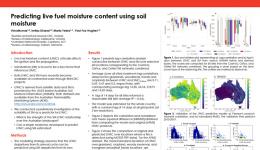Project leadership
This project examined the use of detailed land surface models, satellite measurements and ground-based observations for the monitoring and prediction of landscape dryness. The research team developed a standalone prototype land surface modelling system, called Joint UK Land Environment Simulator based Australian Soil Moisture Information (JASMIN) to produce daily soil moisture analyses at 5km resolution and 4 soil layers. Verification against ground-based soil moisture observations shows that this prototype system is significantly more skilful than both the Keetch–Byram Drought Index and Soil Dryness Index. This project also aimed to improve applications such as fire danger mapping that may require soil moisture information at higher spatial resolution due to the large spatial variability of soil moisture in the landscape, and developed a simple yet skilful model to predict live fuel moisture content for the whole of Australia.
This project is part of the Black Summer research program funded by the Commonwealth Government through the 10-year extension of funding into natural hazard research in Australia.
Lead end user
This project is using high-resolution modelling, together with a range of meteorological data, to better understand and predict important meteorological natural hazards, including fire weather, tropical cyclones, severe thunderstorms and heavy rainfall. The outcomes from the project will contribute to reducing the impact and cost of these hazards on people, infrastructure, the economy and the environment.
Research team:
This project examined the use of detailed land surface models, satellite measurements and ground-based observations for the monitoring and prediction of landscape dryness. The research team developed a standalone prototype land surface modelling system, called Joint UK Land Environment Simulator based Australian Soil Moisture Information (JASMIN) to produce daily soil moisture analyses at 5km resolution and 4 soil layers. Verification against ground-based soil moisture observations shows that this prototype system is significantly more skilful than both the Keetch–Byram Drought Index and Soil Dryness Index. This project also aimed to improve applications such as fire danger mapping that may require soil moisture information at higher spatial resolution due to the large spatial variability of soil moisture in the landscape, and developed a simple yet skilful model to predict live fuel moisture content for the whole of Australia.
Research team:
Supervisory roles
Research team
| Type | Project | Research team |
|---|---|---|
| Tactical Research Fund | Predicting fire danger ratings from physical measures of fire behaviour | pfoxhughes |
| Tactical Research Fund | Characterisation of synoptic weather features often associated with extreme events in south east Australia and Tasmania | tremenyi, plove, pfoxhughes |
| Commissioned Research | Modelling fire weather interactions using the ACCESS-Fire model | jkepert, pfoxhughes, bhanstrum, dzovkorajak, asantra, jgreenslade |
31 Aug 2020
Key findings: The study explores the live fuel moisture – soil moisture relationship at a national...
27 Aug 2019
January 2013 fire season was among the most significant seasons in Tasmanian history.
27 Aug 2019
The Australian Fire Danger Rating System Program is building a new fire danger rating system.
19 Sep 2018
The present study discuss the development and evaluation of a new soil dryness product based on an...
18 Aug 2015
Fire influences climates through emission of gas and particles into the atmosphere.Advances in...




















